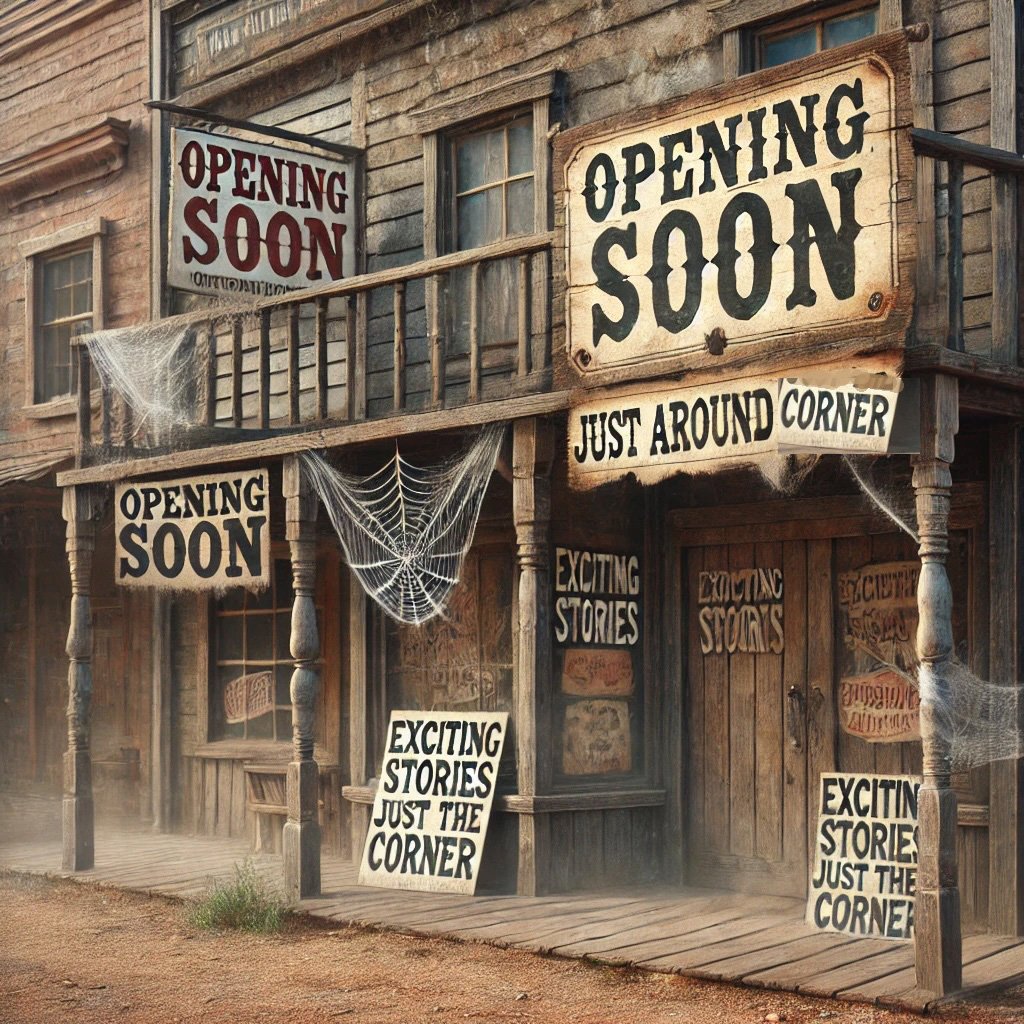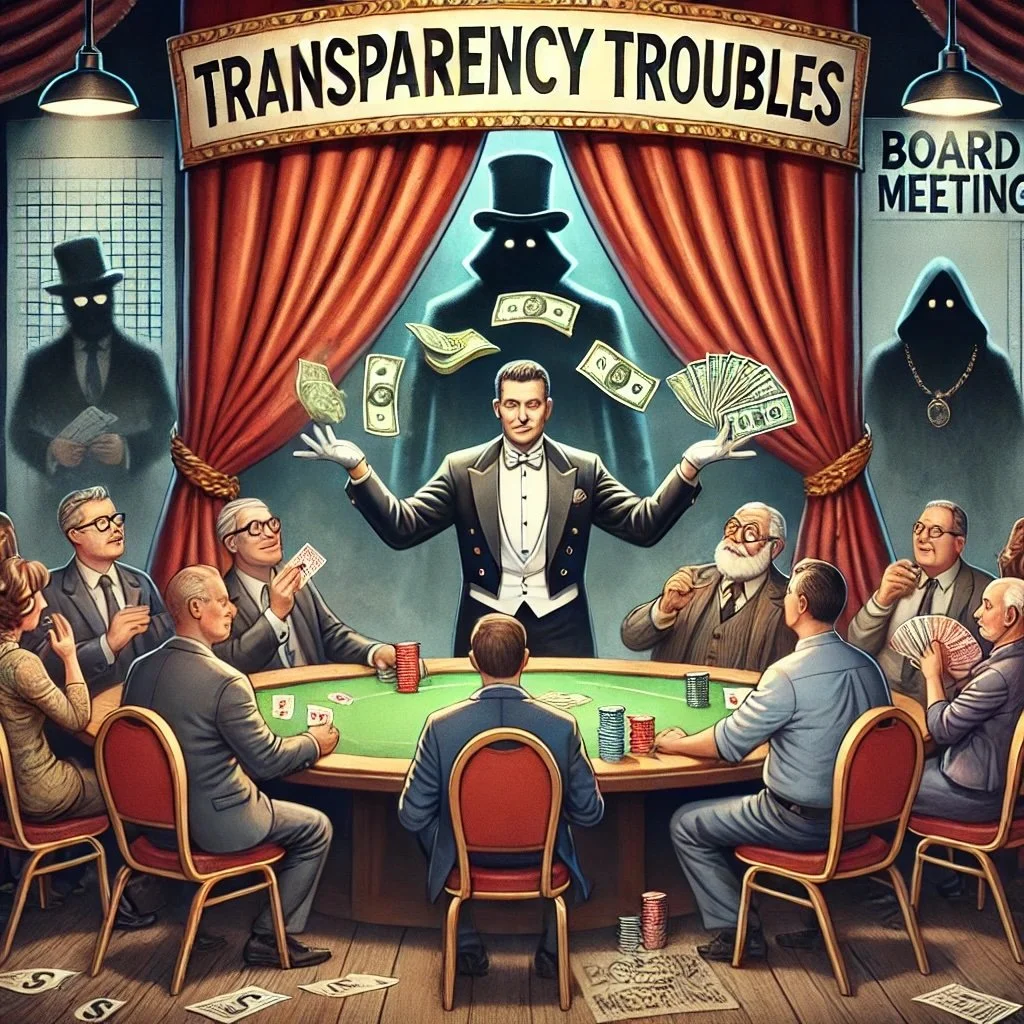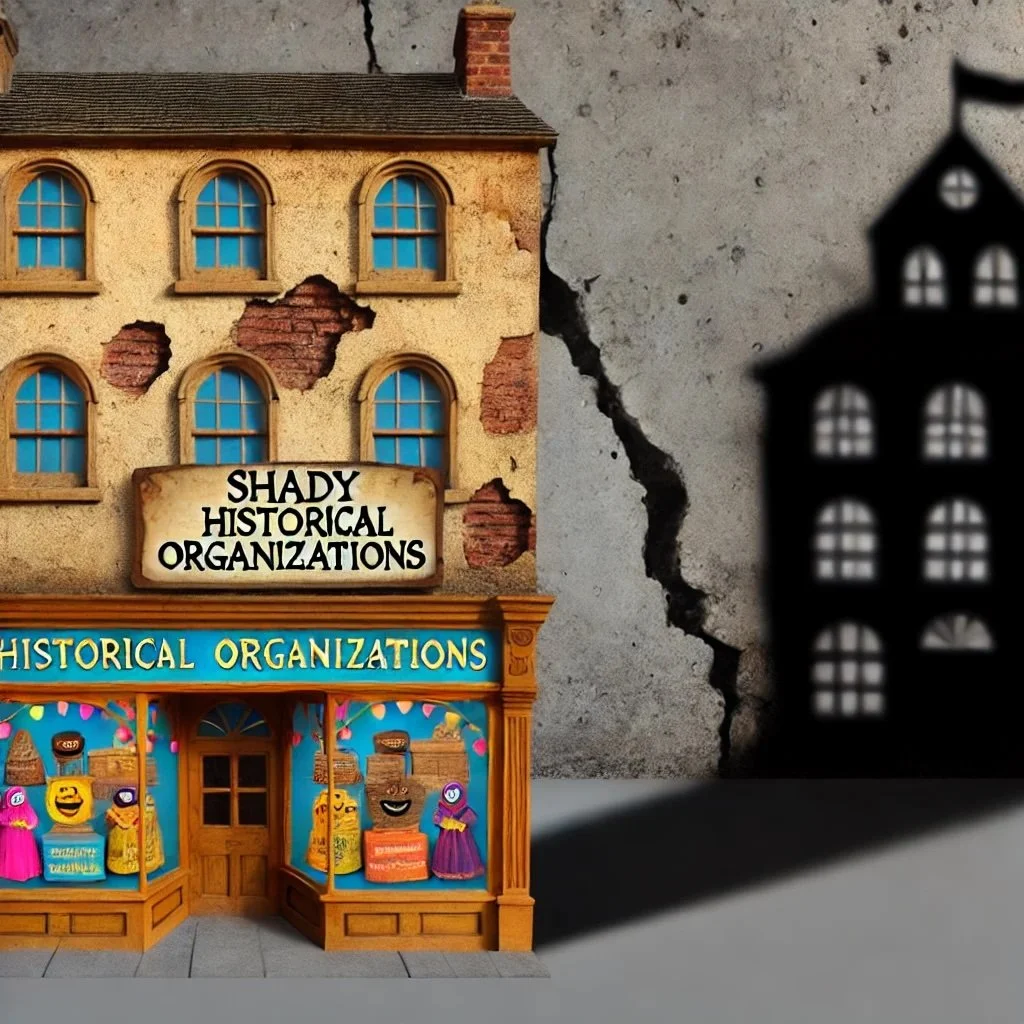Museum of Red Flags: How History Groups Go Rogue
Museum of Red Flags
Maybe something’s in the air, but lately, I’ve been flooded with questions about historical organizations (mostly, “How do you know if this one is legit?”). And while I write and podcast about history, I don’t have an inside pass to what goes on behind various organization’s doors.
As a journalist who’s written extensively about local historical organizations, my experiences have always been positive—stellar, even. Many people I’d interviewed later became friends, and those working at these organizations have proven to be trustworthy, passionate, and dedicated to preserving the past. When course corrections are needed, they handle them with transparency. Very inspiring.
I never worried about those types of organizations until later when I ran into “the others.” These are the ones operating in the shadows. But, since we journalists talk to each other, I knew the ones to avoid. I’d managed to mostly steer clear of them, much as I do with those spine-snapping potholes in Minnesota in late December. But sometimes you can’t avoid potholes—especially when they’re hidden under a fresh blanket of snow.
All these questions piqued my reporter’s curiosity, and what I uncovered would make your hair stand on end. Whether it’s an old Victorian mansion, a rusted-out factory, or Grandma’s shoebox full of love letters from WWII, these are all pieces of our history—the things that shape who we are. They need to be treated with respect.
The Siren Call: Big Promises, Bigger Collections
Now, enter a so-called “historical preservation society” with a name longer than a Constitutional amendment and promises just as grand. “We’ll save it all!” they proclaim, rattling their collection boxes like seasoned pros.
And we often fall for it—hook, line, and sinker. Who wouldn’t want to be part of preserving history, especially when we feel emotionally connected to it?
These organizations see us coming from a mile away. They roll out the marketing: tear-jerking videos, flashy brochures, and photos of old-timey buildings bathed in golden light. And we hand over our money quicker than you can say “tax-deductible donation.”
But just because they make it look good doesn’t mean they’re doing good. Behind the polished presentations and practiced speeches, some of these organizations cut corners, misuse funds, or worse—use your donations for their own gain.
Fortunately, the following two examples are rare—but serve as solid cautionary tales.
The Wheaton Hoodwink
Full disclosure. Chicago-based friends and family shared the story of the rise and fall of the Wheaton History Center (Wheaton, IL) with me, so it was one of the first organizations that I researched. Also, there’s a lot more to this story, but I’m only sharing the highlights.
The story of the Wheaton Historical Preservation Council (WHPC) is a cautionary tale that hits close to home for many small-town historical societies. Founded in 1984, the WHPC started with a clear mission: to preserve the history and architecture of Wheaton, Illinois. For years, they were a cornerstone of the community, running the Wheaton History Center and offering popular programs like walking tours and lectures.
These groups often run on passion, volunteer power, and community support. The WHPC was no different, relying on dedicated volunteers, generous donors, and engaged members to keep the wheels turning.
But somewhere along the line, things went sideways. By 2024, the WHPC found itself in hot water. The Illinois Attorney General’s office filed a lawsuit alleging that over $300,000 in charitable funds had been misused, with money allegedly going to the council president. To make matters worse, after closing their museum in 2017, there were questions about how they handled their historical artifacts.
This situation highlights a real problem many historical societies face: maintaining financial transparency and proper governance, especially when resources are tight and oversight might be limited.
According to recent articles, the WHPC’s collection sits in a city storage facility, out of public view. Their once-vibrant programs have ground to a halt as they grapple with legal issues. It’s a stark reminder of how quickly things can unravel, even for organizations with the best of intentions.
This story resonates because it could happen anywhere. It underscores the need for strong oversight, clear financial controls, and ongoing community engagement in our local historical organizations. After all, these groups are custodians of our shared past, and their integrity is crucial to preserving our history for future generations. (Link to the article: ATTORNEY GENERAL RAOUL FILES LAWSUIT AGAINST WHEATON HISTORICAL PRESERVATION COUNCIL OVER ALLEGED MISUSE OF FUNDS)
The San Diego Swindle
Another full disclosure: I hadn’t heard of this caper before, but Jill Castellano’s article was so well-researched and well-written that I had to share it as a prime example of exposing these kinds of shenanigans.
San Diego’s Save Our Heritage Organisation (SOHO), a leading historic preservation nonprofit, found itself in hot water after its leadership turned a preservation project into a personal antique roadshow. Here’s how it all unraveled:
The executive director and the education and communications director—who happen to be married—decided to “relocate” $70,000 worth of SOHO’s antiques to their private mansion in Mississippi. You know, for safekeeping… or maybe just redecorating.
They even used the antiques during a mansion tour, pocketing a nice cut of the ticket sales. But don’t worry—they claim they spent more on prepping for the tour than they made. So, all good, right?
To add a little extra flair, they listed their mansion for sale, complete with SOHO’s antiques in the photos. While the listing proudly boasted “original antiques included,” they denied trying to sell SOHO’s property. Just a little “whoopsie,” apparently.
The antiques stayed in Mississippi for over two years, only making their way back to California after a few complaints rattled SOHO’s board. But by then, some of the pricier pieces had mysteriously vanished from the loan sheet. Oops, must’ve misplaced those!
An “independent” audit was conducted, though its impartiality was questioned, given the auditor’s cozy relationship with SOHO. Naturally, this led to some board shake-ups and resignations.
In the end, SOHO learned the hard way about the importance of paperwork and policies. They’ve since implemented new rules requiring board approval before any future antique road trips.
Lesson learned: just because you’re preserving history doesn’t mean you should take it home with you!
This case serves as a cautionary tale for historical societies and nonprofits, emphasizing the need for clear policies, proper documentation, and strong oversight to maintain integrity and public trust in the vital work of preserving cultural heritage. (Link to the article: A San Diego nonprofit’s historical antiques landed in Mississippi. A bitter conflict followed)
How to Spot a History Hustler
So, how do you know when one of these history hucksters is pulling a fast one? Grab your magnifying glass, Watson—we’re about to do some detective work.
Cobwebbed Websites
Picture yourself strolling through an old Wild West ghost town. Dusty streets, creaky saloon doors swaying in the wind, and storefronts that haven’t seen a customer since the days of the Pony Express. That’s exactly the vibe you get when you stumble upon one of these cobwebbed websites.
You’ll find pages with no content, like empty shops with signs saying “Opening Soon” that have clearly been forgotten. Announcements from ages ago hang like faded posters for a hoedown long since passed. And those placeholders? They promise “exciting stories just around the corner,” — but that corner--and the stories--never appear, leaving you stranded in a town where time is forgotten.
On the flip side, a well-maintained website feels like a bustling frontier town where the sheriff’s in charge, the general store’s fully stocked, and everyone’s doing their part. That’s the kind of place you can usually trust—though, of course, even the nicest websites can be deceiving. It’s always good to dig a little deeper before you fully buy in, just in case the shiny storefront is hiding something shady in the back room.
Transparency Troubles
If trying to figure out who's running the show feels like cracking the Da Vinci Code, you have a bigger problem than the national debt. Remember our pals at Wheaton? Their board sneakily funneled funds to their president faster than a pickpocket at a crowded train station. It's like they were running a magic show: "Now you see the funds… now you don't!"
A trustworthy group should lay it all out for you—financial reports, board meeting minutes, and a clear breakdown of what they're doing with donations. If they're not sharing that info, it's like sitting down at a poker table and realizing you're the only one without a hand. If it feels like everything's happening behind a curtain, chances are they're hiding more than just a dusty ledger.
Future Faking
Now, let’s talk about an age-old tactic with a new name: future faking. It’s like being promised a gourmet meal but ending up with a stale sandwich. These historical hucksters are pros at painting pictures of exciting projects and events “coming soon.” You open your wallet, spread the word, and maybe even convince your family to pitch in some extra funds. But as the seasons change, that grand reveal remains as elusive as ever. Meanwhile, they’re already hyping the next “revolutionary” project—also just around the bend.
A friend of mine experienced this firsthand when she landed what seemed like a dream gig at a preservation nonprofit. They filled her head with visions of career-launching opportunities. Three months in, the big boss called her in to say, “Sorry, kiddo, we ran out of money.” Instead of a simple thank you, they suggested she keep working for free—because, of course, “it’ll look great on your resume.” She wasn’t born yesterday, so she walked out, but the experience left a bitter taste.
This kind of letdown doesn’t just bruise the ego; it shakes faith in the entire field. It’s a reminder that even in history, some folks are more interested in preserving their own interests.
Ego-Driven Leadership
History is supposed to be about the stories—the people, places, and moments that shaped the world. It's definitely *not* supposed to be about the people running the organization. But when leadership acts like they're the star of the show, you've got a big problem. If they're more interested in promoting themselves than preserving the past, it's time to hit the brakes harder than a student driver at a red light.
Look no further than our pals in San Diego at Save Our Heritage Organisation (SOHO). They started out preserving historic buildings, but it didn't take long before leadership got a little too cozy. They shipped antiques meant for public display all the way to their personal mansion for a "home tour," without so much as a heads-up to the board. It's a classic case of "Look at me, not the history!" And don't be fooled—just because someone's vocal or charismatic doesn't mean they're acting in history's best interest. Sometimes, they're just acting—badly.
History Hoarders: When Artifacts become Power Plays
To highlight the unethical practices of certain historical organizations, it’s important to address the issue of artifact and donation hoarding. Many well-meaning individuals donate family artifacts, photos, and personal stories to such organizations, believing their contributions will be shared with the public to preserve history. However, instead of making these invaluable resources accessible, some organizations merely hint at the acquisitions through social media posts, offering little to no detail about the items themselves. These teasers often create a false sense of transparency while keeping the actual content under wraps.
This tactic not only undermines the trust of the donors but also restricts access to important historical information that could benefit researchers and the public. By withholding these materials, the organization stifles the broader understanding of the events or communities they claim to represent, placing their own control over these artifacts above the needs of history and the communities tied to it.
Helpful Hints
For those who have already donated to these types of organizations, it’s important to know that you still have options. Start by reaching out to the organization and inquiring about how your donation is being used. Request specifics—whether your family’s artifacts or stories have been archived, shared, or are available for research.
If you receive vague or unsatisfactory responses, consider escalating the issue. Some organizations are legally obligated to document and disclose their handling of donations, so you can explore this through local or state channels, such as the Secretary of State’s office or even legal avenues. If your donation was made with specific intentions that are not being honored, you may have grounds to request its return.
Share your experience with others. Your voice could help prevent future donors from falling into the same situation and push for greater accountability from the organization. You can also consider collaborating with trusted historical organizations to preserve your family’s legacy in the way you intended
Inconsistent or Missing Sources
Have you ever read something from one of these organizations and thought, “Where the heck did they get that?” If an organization is cutting corners on research or cherry-picking details to fit their narrative, they’re not preserving history—they’re rewriting it as they go. It’s like watching a movie “based on a true story” that suddenly turns into a superhero flick halfway through.
An authentic group backs up their claims, gives credit to the folks who did the legwork and doesn’t pull facts out of thin air. If their sources are scarcer than a needle in a haystack—or if they’re missing altogether—you’ve got yourself a history rewrite in the making. Think of it like this: if they’re not citing anything, they’re either hiding something or just too lazy to hit “Ctrl+C” on an actual source.
What else can you do?
.
So, what can you do to avoid falling into the trap of shady historical organizations? Here are some steps you can take:
Support the tried-and-true: Stick with organizations that have a long history of transparency and trustworthiness in your community.
Do your homework: Look up the organization through your Secretary of State’s office, check for complaints with the Better Business Bureau, or see how they’re rated by watchdog groups like Charity Watch or Charity Navigator.
Verify their status: Confirm their tax-exempt status and track record before making donations or entrusting them with your family heirlooms.
Get involved: attend board meetings, volunteer, or become a member. This gives you an inside look at how the organization operates.
Ask questions: Don’t hesitate to inquire about their policies for accepting and loaning artifacts, or how they ensure proper care and documentation of donations.
Review financial reports: Many nonprofits publish annual reports. Take time to read these and understand how they’re using their resources.
Spread awareness: Share positive experiences with reputable organizations in your community. Word of mouth can help steer others towards trustworthy groups.
Support education initiatives: Back programs that teach the importance of ethical practices in historical preservation.
The Good News!
Remember, the majority of historical societies and museums are run by dedicated, passionate individuals who genuinely care about preserving our shared heritage. By being an informed and engaged supporter, you’re not just protecting your own interests—you’re helping to maintain the integrity of our historical record for future generations.
Moreover, your involvement can have a ripple effect. As more people engage with these organizations, it creates a culture of transparency and accountability. This not only helps prevent mismanagement but also strengthens these vital institutions, ensuring they can continue their important work of connecting us with our past and informing our future.
In the end, preserving history is a community effort. Our vigilance, support, and participation play a crucial role in keeping our historical organizations strong, ethical, and effective. So get out there, visit your local historical society, attend an event, or make a donation. Our engagement today helps safeguard our history for tomorrow.
The Last Word
Here’s the heart of the matter—these aren’t just artifacts and buildings we’re talking about. They’re pieces of our collective story. Your great-grandfather’s war medal isn’t just metal and ribbon; it’s a tangible link to his courage and sacrifice. That quirky hometown landmark isn’t just an odd structure; it’s a shared reference point for generations of locals.
When organizations promise to preserve these treasures, they’re not just offering to safeguard objects. They’re pledging to protect our memories, our family legacies, and our community identity. That’s why it’s so easy to get swept up in their grand promises. We desperately want someone to care for these pieces of our past as much as we do.
But this deep attachment to our past is exactly what leaves us open to vulnerability. When a well-credentialed historical society comes in, brimming with grand plans and lofty promises, our desire to see our history safeguarded can blur our judgment. We may ignore warning signs or silence lingering concerns, simply because we’re so eager to trust that someone will protect and honor the memories we hold dear.
This is why it’s crucial to balance our passion for preservation with a healthy dose of skepticism. Our history is too important to entrust to just anyone with a slick pitch. By being vigilant and asking tough questions, we’re not being cynical—we’re being the true guardians of our shared past.
Links:
A San Diego nonprofit’s historical antiques landed in Mississippi. A bitter conflict followed (inewsource)
ATTORNEY GENERAL RAOUL FILES LAWSUIT AGAINST WHEATON HISTORICAL PRESERVATION COUNCIL OVER ALLEGED MISUSE OF FUNDS (National Association of State Charity Officials (NASCO)
Shuttered organization dedicated to preserving Wheaton’s history ‘took advantage’ of donors, misused funds ‘for their own benefit,’ state lawsuit alleges (Chicago Tribune)











